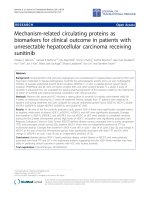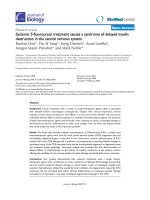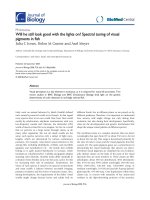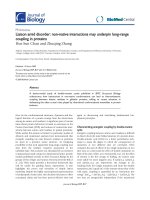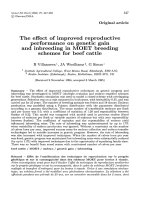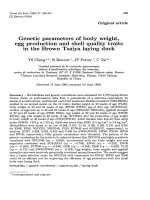Báo cáo sinh học: "properties related Drosophila melanogaster strains with altered fitness also show changes in their hobo element " doc
Bạn đang xem bản rút gọn của tài liệu. Xem và tải ngay bản đầy đủ của tài liệu tại đây (831.02 KB, 12 trang )
Original
article
Closely
related
Drosophila
melanogaster
strains
with
altered
fitness
also
show
changes
in
their
hobo
element
properties
VN
Bolshakov
AP Galkin
2
LZ
Kaidanov
2
VA
Gvozdev
3
C
Louis
1
Institute
of Molecular
Biology
and
Biotechnology,
FORTH,
PO
Box
1527,
711.10 Heraklion,
Crete,
Greece;
2
Saint
Petersburg
State
University,
Department
of
Genetics,
Saint
Petersburg,
Russia;
3
Russian
Academy
of Sciences,
Institute
of Molecular
Genetics,
Moscow,
Russia;
University
of
Crete,
Department
of
Biology,
Heraklion,
Crete,
Greece
(Received
4
August
1993;
accepted
5
January
1994)
Summary -
A
set
of
Drosophila
melanogaster
strains
of
common
origin,
but
with
different
fitness
characteristics,
established
either
spontaneously
or
after
selection
for
the
specific
fitness
parameters,
appear
to
induce
non-P-element-mediated
gonadal
atrophy
in
appropriate
crosses
to
tester
strains
containing
or
lacking
hobo elements
(H
and
E
strains).
Using
the
gonadal
dystrophy
(GD)
sterility
assay,
as
well
as
genomic
Southern
blot
hybridization
and
in
situ
hybridization
on
polytene
chromosomes,
it
was
found
that
all
these
strains
possess
hobo
elements
whose
dysgenic
activity,
composition,
copy
number
and
cytogenetic
locations
appeared
to
be
variable.
In
general,
low
fitness
strains
have
moderate
hobo-activity
and
hobo-repression
potentials,
while
high
fitness
strains
show
no
hobo-activity
but
also
quite
high
hobo-repression
potentials.
Although
distinct
differences
in
the
composition,
copy
number
and
location
of
the
hobo
elements
in
the
genome
were
observed
between
these
2
groups
of
strains,
these
variations
did
not
show
any
profound
correlation
with
either
hobo-related
dysgenic
potential
or
the
fitness
of
the
strains.
Drosophila
melanogaster
/
selection
/
fitness
/
transposable
element
/
hobo
Résumé -
Des
souches
étroitement
apparentées
de
Drosophila
melanogaster
avec
des
aptitudes
reproductives
modifiées
manifestent
aussi
des
changements
dans
les
propriétés
de
leurs
éléments
hobo.
Différentes
lignées
de
Drosophila
melanogaster,
issues
d’une
population
naturelle
russe,
ont
été
sélectionnées
sur
des
caractéristiques
de
fitness.
Ces
lignées,
comme
les
lignées
témoins,
présentent
des
activités
dysgéniques
variables
non
reliées
à
l’élément
transposable
P.
Nous
montrons
que
la
stérilité
GD
(gonadal
dystrophy)
qu’elles
induisent
est
due
à
l’élément
hobo
et,
de
plus,
que
ces
lignées
ont
des
potentiels
*
Correspondence
and
reprints
dysgéniques
différents.
Les
analyses
moléculaires
réalisées
par
buvardage
de
Southern
et
par
hybridation
in
situ
sur
les
chromosomes
polytènes
font
apparaître
que
ces
lignées
possèdent
un
nombre
variable
d’éléments
hobo,
qui
ont
des
structures
et
des
localisations
cytogénétiques
différentes.
En
général,
les
lignées
ayant
une
fitness
basse
présentent
une
activité
hobo
et
un
potentiel
de
répression
modérés,
alors
que
les
lignées
ayant
une
fitness
plus
forte
n’ont
pas
d’activité
hobo,
mais
un
potentiel
de
répression
assez
élevé.
Bien
que
ces
2 groupes
diffèrent
par
la
structure,
le
nombre
et
la
localisation
cytogénétique
de
leurs
éléments
hobo,
les
différences
mises
en
évidence
ne
montrent
pas
de
corrélation
directe,
que
ce
soit
avec
le
potentiel
dysgénique
ou
avec
la
fitness
des
lignées
analysées.
Une
relation
entre
les
sélections
réalisées
pour
établir
les
lignées
et
l’évolution
de
leurs
éléments
hobo
est
discutée.
Drosophila
melanogaster
/
sélection
/
fitness
/
élément
transposable
/
hobo
INTRODUCTION
The
evaluation
of
the
genetic
consequences
of
selection
is
one
of
the
key
purposes
of
population
genetics,
especially
in
the
context
of
the
theory
of
breeding
(Hill
and
Caballero,
1992).
To
address
this
problem,
a
set
of
Drosophila
melanogaster
strains,
originating
from
a
natural
population
from
Yessentuki
(Russia),
was
established
after
close
inbreeding
and
long-term
selection
for
differences
in
male
mating
activity.
Selection
for
low
male
mating
activity
also
led
to
correlated
changes
in
a
number
of
morphological,
physiological,
behavioural,
biochemical
and
genetic
features
which,
altogether,
greatly
reduced
the
overall
fitness
of
these
strains,
and
thus
made
it
possible
to
characterize
them
as
low
fitness
or
high
fitness
strains
(reviewed
in
Kaidanov,
1980,
1990).
In
spite
of
the
close
inbreeding,
these
strains
appeared
to
possess
a
significant
genetic
load
and
a
high
rate
of
spontaneous
mutability,
including
the
occurrence
of
chromosomal
rearrangements
(Kaidanov,
1980,
1990;
Kaidanov
et
al,
1991).
Experiments
directed
to
investigate
the
sources
of
this
genetic
instability
showed
that
in
the
course
of
isogenization
of
the
strains’
2nd
chromosomes
in
order
to
evaluate
their
genetic
loads
and
the
rates
of
spontaneous
mutability,
the
female
progeny
exhibited
a
high
rate
of
gonadal
dystrophy
(GD).
In
these
crosses,
males
from
one
of
the
low
fitness
strains,
LA,
were
crossed
with
the
females
of
a
laboratory
strain
containing
a
balancer
for
the
2nd
chromosome.
This
finding
was
highly
reminiscent
of
hybrid
dysgenesis,
a
syndrome
attributed
to
the
activation
of
the
transposable
elements
P
or
hobo
(Louis
and
Yannopoulos,
1988;
Blackman
and
Gelbart,
1989;
Engels,
1989).
Since
it
was
known
that
LA
does
not
contain
any
P
elements
in
its
genome
(Pasyukova
et
al,
1987),
the
probability
that
hobo
elements
were
responsible
for
the
GD
sterility
detected
was
checked
by
crosses
to
appropriate
tester
strains,
containing
or
lacking
hobo
elements.
These
experiments
revealed
the
presence
of
active
hobo
elements
in
LA
(Kaidanov
et
al,
1991)
thus
raising
the
possibility
that
hobo
may
be
the
causative
factor
for
the
genetic
instability
observed.
We
extended
our
analysis
to
several
strains
which,
though
related,
exhibited
different
fitness
characteristics.
Here,
we
report
results
on
composition,
copy
number,
cytogenetic
location
and
dysgenic
properties
of
their
hobo
elements.
MATERIALS
AND
METHODS
The
following
D
melanogaster
strains
(kept
on
standard
corn-meal
food
at
25°C)
were
used
for
experiments:
LA:
low
activity
strain,
obtained
from
a
natural
population
in
Yessentuki
(Russia)
in
1965
as
a
result
of
inbreeding
and
long-term
selection
for
low
male
mating
activity.
By
the
time
of
the
beginning
of
the
experiments
described
here,
it
had
passed -
600
generations
of
selection.
HA
and
LA
+:
high
activity
strains,
obtained
independently
from
LA
at
its
70th
and
163rd
generation
of
maintenance,
respectively,
by
selection
for
high
male
mating
activity
and
close
inbreeding.
These
3
strains
(LA,
HA
and
LA
+)
were
kept
in
the
collection
as
families
obtained
from
individual
brother-sister
matings
and
were
described
in
detail
by
Kaidanov
(1980,
1990).
LA6-
and
LA6
+:
low
activity
and
high
activity
strains,
respectively,
selected
by
close
inbreeding
from
a
high
fitness
strain
(LA6)
that
arose
spontaneously
from
one
of
the
families
of
LA,
and
was
subsequently
lost
from
the
collection.
After
the
initial
selection
and
close
inbreeding,
LA6-
and
LA6‘
+
are
kept
in
the
collection
by
mass
mating
without
further
selection.
LApas:
low
activity
strain,
established
from
one
of
the
families
of
LA
and
reared
by
mass
mating
without
further
selection.
23.5MRF/CyL
4:
a
strain
containing
active
P
and
hobo
elements
(PH-strain)
and
capable
of
weak
induction
of
P-M
hybrid
dysgenesis
and
strong
induction
of
H-E
hybrid
dysgenesis
(Yannopoulos
et
al,
1987;
Stamatis
et
al,
1989).
CyL/Pm:
an
ME
strain
containing
a
2nd
chromosome
balancer
and
unable
to
suppress
H-E
hybrid
dysgenesis.
Female
progeny
resulting
from
crosses
between
this
strain’s
females
to
23.5MRFICyL
males
exhibit
high
levels
of gonadal
atrophy
(Kaidanov
et
al,
1991).
The
test
for
male
mating
activity
was
performed
as
described
by
Kaidanov
(1980,
1990).
Single
mature
males
from
the
strain
to
be
tested
were
put
in
the
same
vial
with
2-3
virgin-wild
type
females
and
the
process
of
copulation
was
observed.
Male
mating
activity
was
determined
as
the
percentage
of
males
succeeding
in
copulating
with
virgin
females
within
30
min.
For
each
strain,
55-90
males
were
tested.
The
GD
sterility
assay
was
performed
according
to
the
conditions
described
by
Yannopoulos
(1978).
To
determine
the
hobo-activity
potential,
the
males
of
the
strain
under
investigation
were
crossed
with
the
CyL/Pm
tester
females,
while
to
determine
the
hobo-repression
potential,
the
females
of
the
strain
were
crossed
with
23.5MRFICyL’
males.
As
a
control,
the
GD
sterility
assay
was
also
performed
both
within-strain
and
for
the
reciprocal
crosses.
All
crosses
were
performed
at
25°C
to
maximize
the
manifestation
of
H-E
hybrid
dysgenesis
(Stamatis
et
al,
1989).
Female
progeny
were
collected
every
day
and
transferred
to
fresh
vials for
3-4
d
for
maturation
of
the
gonads,
which
were
then
dissected
to
analyze
their
morphology.
The
induction
of
GD-sterility
was
measured
as
the
frequency
of
atrophic
gonads.
For
each
strain,
1-4
replicates
of
each
cross
were
performed
and
50-500
females
were
scored.
Genomic
DNA
for
Southern-blot
hybridization
was
extracted
from
200
flies/
strain
as
described
by
Ashburner
(1989).
Approximately
2
pg
DNA
was
digested
with
Xho
I
restriction
endonuclease,
separated
electrophoretically
in
1.2%
agarose
gels
and
blotted
onto
nylon
membrane
filters
following
standard
protocols
(Sam-
brook
et
al,
1989).
Hybridization
was
performed
according
to
Church
and
Gilbert
(1984)
using
as
a
probe
32P-labelled
plasmid
pHFLl
which
contains
a
complete
hobo
element
(Blackman
et
al,
1989).
In
situ
hybridization
to
salivary
gland
polytene
chromosomes
was
performed
as
described
by
Ashburner
(1989),
using
biotin-labelled
plasmid
pHcSac,
containing
a
complete
hobo
element
as
a
probe
(Stamatis
et
al,
1989).
The
t-test
(Sokal
and
Rohlf,
1969)
was
used
to
compare
the
means
in
our
experiments.
RESULTS
Male
mating
activity
As
some
of
the
strains
under
investigation
are
kept
without
any
further
selection
with
respect
to
their
male
mating
activity,
we
first
performed
a
series
of
tests
for
all
LA
derivatives
analyzed
here.
The
data
on
their
male
mating
activity
are
presented
in
table
I.
They
confirm
the
status
of
LA
and
LApas
as
low
activity
strains
(no
matings
within
the
first
30
min).
The
remaining
strains
showed
a
gradual
increase
in
male
mating
activity,
from
25.0
and
52.0%
for
the
more
recently
established
strains
LA6-
and
LA6‘!
to
76.6
and
94.0%
for
HA
and
LA
+
which
had
been
established
earlier.
Activity
and
repression
abilities
of
hobo
elements
As
the
strains
under
investigation
were
previously
shown
not
to
contain
any
P
elements
(Pasyukova
et
al,
1987),
we
concentrated
our
analysis
on
the
study
of
hobo-mediated
genetic
instability.
The
hobo-activity
potential
of
the
strains
was
determined
by
the
GD
sterility
assay
using
the
females
from
the
E
strain
CyL/Pm
as
tester
strains,
a
high
percentage
of
dystrophic
gonads
in
the
progeny
of
these
crosses
being
indicative
of
a
higher
hobo-mediated
dysgenic
induction.
The
hobo-
repression
potential
was
determined
in
a
similar
way,
this
time
crossing
females
from
the
LA
derivatives
with
males
of
the
H-strain
23.5MRF/CyL
4.
In
this
case,
the
higher
the
proportion
of
atrophic
gonads
among
female
progeny,
the
lower
the
potential
of
the
strain
under
investigation
to
repress
the
action
of
hobo.
In
a
test
cross
of
CyL/Prrz
females
to
23.MRF/CyL
4
males,
the
GD
sterility
among
150
female
progeny
reached
90%,
confirming
that
the
latter
still
retained
its
strong
hobo-activity
potential.
As
a
control,
intrastrain
GD
sterility
assays
were
performed
and,
with
the
only
exception
of
LA,
where
intrastrain
sterility
reached
a
moderate
rate
of
about
12%,
the
proportion
of
atrophic
gondas
in
all
other
strains
did
not
exceed
the
background
levels
(0-2.5%,
table
I).
For
both
experiments,
in
control
reciprocal
crosses,
the
proportion
of
atrophic
gonads
was
very
low
if
any
(0-1.6%,
table
I),
thus
implying
that
the
hobo
elements
are
the
most
probable
causative
factors of
the
GD-
sterility
in
experimental
crosses.
The
data
presented
in
table
I
show
that
low
activity
strains
LA
and
LApas
appeared
to
have
similar
moderate
hobo-activity
potential
(32.6
and
36.5%
of
atrophic
gonads,
respectively;
t =
0.66,
p
>
0.05),
while
the
intermediate
strains
LA6‘
and
LA6
+
and
the
high
activity
strains
HA
and
LA
+
apparently
lost
their
induction
potential
sometime
after.
their
establishment
(GD
sterility
=
0-0.8%).
The
hobo-repression
potential
was
lowest,
though
different,
for
LA
and
LApas
(47.0
and
38.0%
of
atrophic
gonads,
respectively;
t
=
2.18,
p
<
0.05).
Strains
LA6-
and
LA6
+
showed
similar
hobo-repression
potentials
(GD
sterility
=
25.0
and
23.0%,
respectively;
t
=
0.25,
p
>
0.05),
which
were
significantly
higher
than
that
of
LApas
(t
=
2.06,
p
<
0.05
and
t =
2.19,
p
<
0.05,
respectively).
The
strongest
hobo-repression
potentials
were
observed
in
LA
+
and
HA
(19.8
and
14.0%
of
atrophic
gonads,
respectively;
t =
1.63,
p
>
0.05),
values
that
are
not
significantly
different
from
that
observed
for
LA6‘!
(t
=
0.63,
p
>
0.05
and
t =
1.44,
p
>
0.05,
respectively).
Composition
of
hobo
elements
Genomic
DNAs
of
the
strains
were
digested
with
Xho
I
restriction
endonuclease,
which
has
recognition
sites
close
to
both
ends
of
the
complete
hobo
element,
yielding
a
characteristic
fragment
of
2.6
kb
after
Southern-blot
hybridization
with
a
hobo
probe.
In
addition,
Xho
I
digests
also
produce
fragments
of
smaller
molecular
weight,
corresponding
to
different
internal
deletion
derivatives
of
hobo
(Streck
et
al,
1986).
As
a
control,
23.5MRF/CyL
4
flies
were
also
analyzed
(fig
lA),
showing
their
characteristic
pattern
of
hybridization
(Stamatis
et
al,
1989),
while
as
expected,
no
hybridization
corresponding
to
either
complete
or
deleted
hobo
elements
was
seen
in
the
corresponding
digests
of
the
CyL/Prn,
strain
(fig
lA),
confirming
that
it
is
a
bona
fide
E
strain
(Kaidanov
et
al,
1991).
All
tested
LA
derivatives
appeared
to
possess
the
2.6
kb
fragment
indicating
the
presence
of
full-length
hobo
elements
in
their
genome.
On
the
other
hand,
the
pattern
of
hobo-deletion
derivatives
was
qualitatively
and
quantitatively
different
for
all
strains
(fig
1B).
In
LA,
the
most
intense
band
has
a
length
of
1.7
kb
with
some
weaker
bands
also
being
present,
while
the
predominant
band
in
LApas
is
2.2
kb
long.
In
the
LA6‘
the
most
prominent
band
also
corresponds
to
a
length
of
1.7
kb
and
there
is
a
very
weak
band
of
1
kb.
The
most
abundant
fragment
in
the
2
high
activity
strains
(HA
and
LA
+)
has
a
length
of
1.15
kb
with
an
additional
intense
band
of
1.4
kb
appearing
in
digest
of
HA
as
well
as
numerous
weaker
bands.
Finally,
the
only
intense
band
observed
in
LA6
+
is
0.9
kb
long.
hobo
elements
copy
number
and
their
distribution
on
the
polytene
chromosomes
To
determine
the
copy
number
of
the
hobo
elements
and
their
location
in
the
genome
of
the
strains
under
investigation
we
performed
an
in
situ
hybridization
of
a
labelled
hobo
element
to
polytene
chromosomes.
Squashes
were
prepared
from
salivary
glands
of
several
larvae,
taken
either
from
one
vial
for
each
strain
kept
by
mass
matings,
or
from
2
vials
(families)
for
each
of
the
strains
kept
in
families.
The
copy
number
of
hobo
elements
and
the
sites
of
their
cytological
location
were
analysed
for
each
individual
larva.
The
data
from
this
experiment
are
presented
in
table
II.
Both
intrastrain
and
interstrain
variation
in
copy
number
and
their
location
are
characteristic
for
all
strains.
In
low
activity
strains
LA
and
LApas
the
number
of
hobo
elements
were
between
12
to
15
and
10
to
22
respectively,
while
in
the
intermediate
activity
strains
LA6‘
and
LA6
+
they
were
from
8
to
11
and
from
13
to
15,
respectively.
Both
high
activity
strains,
HA
and
LA
+,
showed
a
considerably
higher
copy
number
(40-42
and
36-37,
respectively).
The
proportion
of
polymorphic
sites
(expressed
as
the
ratio
of
the
number
of
sites
varying
among
individuals
from
one
strain,
to
the
total
number
of
sites
revealed
within
the
same
strain)
also
appeared
to
be
different
between
the
strains
(table
II).
Quite
low
polymorphism
was
observed
in
strains
kept
as
individual
families
with
selection. HA
had
12%
polymorphic
sites,
the
corresponding
number
for
LA
+
was
24%,
and
a
higher
value
(47%)
was
observed
for
LA
On
the
other
hand,
the
strains
kept
by
mass
matings
without
selection
(LApas,
LA6-
and
LA6
+)
had
even
higher
values
(69,
56
and
63%
of
polymorphic
sites,
respectively).
Analysis
of
cytological
locations
of
hobo
elements
revealed
that,
in
the
course
of
selection
and
subsequent
maintenance
of
the
strains,
their
hobo
elements
underwent
massive
transpositions.
Only
LA
and
LApas
share
9
common
sites
among
a
total
of
46
sites
for
both
strains
(or
20%),
while
all
other
pair-wise
comparisons
revealed
only
2-5
common
sites
among
a
total
of
33-84
sites,
or
3-12%
(table
III).
Another
strain
with
decreased
activity,
LA6-,
shared
only
2
(6.5%)
and
4
(8.9%)
sites
with
LA
and
LApas,
respectively.
Only
2
sites
at
17E and
96E
were
common
to
all
3.
The
high
activity
strains
HA,
LA
+,
and
LA6‘!
had
2-5
sites
in
common
(3.0-7.7%),
and
there
were
no
sites
that
were
shared
by
all
3.
The
most
frequent
sites
among
all
strains
analyzed
were
17A,
38C,
67A
and
96E.
DISCUSSION
In
a
previous
paper
(Kaidanov
et
al,
1991)
we
showed
that
the
D
melanogasterstrain
LA,
established
from
a
natural
population
by
close
inbreeding
and
selection
for
low
male
mating
activity,
harboured
active
hobo
elements
in
its
genome.
We
extended
this
analysis
to
encompass
LA-derivative
strains
with
altered
male
mating
activity,
and
in
this
report
we
present
evidence
that
the
hobo
elements
in
these
strains
underwent
considerable
changes
in
their
dysgenic
properties,
composition
and
copy
number,
accompanied
by
extensive
transpositions.
Both
low
activity
strains,
LA
and
LApas,
preserved
dysgenically
active
hobo
ele-
ments
resulting
in
similar
intermediate
hobo-activity
and
hobo-repression
potentials,
as
revealed
by
the
GD
sterility
assays.
They
also
appear
to
possess
quite
similar
copy
numbers
of
hobo
elements,
and
the
differences
observed
in
the
composition
of
hobo
elements
(notably
the
presence
of
the
prominent
band
of
1.7
kb
in
LA)
and
in
their
locations
in
the
genomes
seem
to
have
no
direct
effect
on
dysgenic
properties
of
both
strains.
In
the
strains
with
intermediate
(LA6-
and
L!46!)
and
high
male
mating
activity
(HA.
and
LA
+)
we
have found
the
full
absence
of
hobo-activity
and
a
considerable
increase
of
hobo-repression
potentials.
These
changes,
especially
evident
in
the
strains
LA6‘!,
HA
and
LA
+,
were
accompanied
by
a
drastic
recomposition
of
hobo-
deletion
derivatives,
which
appeared
to
be
completely
different
from
the
complement
of
LA
and
LApas.
Nevertheless,
our
results
do
not
imply
any
correlation
between
the
presence
or
absence
of
a
deletion
derivative
and
the
dysgenic
properties
and
fitness
of
the
strains
under
investigation.
For
example,
LA
and
LA- have
quite
similar
composition
of
hobo
elements,
yet
they
differ
markedly
in
both
characteristics.
Similarly,
LA
+
and
LA6‘!
have
similar
dysgenic
properties
and
fitness
but
exhibit
strong
differences
in
the
restriction
patterns
of
the
hobo
elements.
More
experiments
are
clearly
needed
to
assess
the
impact
of
different
members
of
the
hobo
element
family
in
the
dysgenic
properties
of
a
given
strain.
While
LA6-
and
LA 6
+
did
not
differ
considerably
from
LA
and
LApas
in
terms
of
the
copy
number
of
hobo
elements,
in
HA
and
LA
+
we
observed
an
amplification
of
the
members
of
this
family.
Not
unexpectedly,
all
these
processes
were
accompanied
by
massive
transpositions
of
hobo
elements.
Although
the
in
situ
hybridization
data
are
limited,
we
could
not
detect
any
specific
transpositions
of
hobo
elements
that
would
be
coupled
to
changes
in
the
dysgenic
properties
or
the
fitness
of
the
strains.
Unlike
the
case
of
copia-like
elements,
which
transpose
from/to
specific
sites
during
selection
for
high
and
low
fitness
(Pasyukova
et
al,
1986),
we
observed
an
almost
complete
reshuffling
in
the
cytological
localization
of
hobo
elements.
Our
data
may
imply
that
the
process
of
change
in
male
mating
activity
of
the
strains
also
changed
some
genetic
mechanisms
regulating
the
activity
of
hobo
elements.
In
spite
of
the
fact
that
hobo
elements
have
been
studied
for
almost
a
decade,
little
is
known
about
the
mechanisms
regulating
their
activity
in
the
genome.
Unlike
active
P
elements,
which
are
fully
suppressed
by
a
P
cytotype,
and
are
inactive
in
the
germline
and
can
be
mobilized
under
normal
conditions
(ie
without
considering
strains
containing
engineered
P
elements)
only
in
dysgenic
crosses
(see
Engels,
1989),
hobo
elements
can
transpose
within
the
strains
known
to
contain
active
hobo
elements
without
a
need
for
outcrosses
(Blackmann
et
al,
1987;
Hatzopoulos
et
al,
1987;
Lim,
1988)
and
they
seem
to
also
be
active
in
somatic
cells
(Kim
and
Belyaeva,
1991).
The
fact
that
hobo
may
play
a significant
role
in
population
biology
is
also
exemplified
by
the
finding
that
these
elements
have
been
found
to
be
located
on
the
breakpoints
of
naturally
occurring
inversions
(Lyttle
and
Haymer,
1992).
It
is
not
surprising
that
most
of
the
D
medanogaster
natural
populations,
although
possessing
both
complete
and
deleted
hobo
elements
in
their
genome,
have
completely
lost
the
ability
to
activate
them
in
dysgenic
crosses
(no
hobo-
activity
potential)
while
strongly
suppressing
the
activity
of
foreign
hobo
elements
(high
hobo-repression
potential)
(Pascual
and
P6riquet,
1991).
This
may
imply
that
some
genetic
mechanisms
develope
to
suppress
the
activity
of
hobo
elements
and
thus
prevent
deleterious
consequences
of
their
transposition
(lethal
mutations
and
chromosomal
rearrangements).
These
mechanisms
may
involve
the
effects
of
some
specific
hobo-deletion
derivatives
that
are
wide
spread
in
natural
populations
(P6riquet
et
al,
1989;
1990)
but
also
other
genetic
factors,
acting
in
both
maternal
and
zygotic
fashion
(Ho
et
al,
1993).
Some
recent
findings
also
imply
that these
mechanisms
can
be
flexible,
as
the
hobo-activity
and
hobo-repression
potentials
in
natural
populations
can
vary
seasonally
and
change
rapidly
when
wild
strains
are
brought
into
a
laboratory
environment
(Zabalou
et
al,
1991).
Considering
this,
we
can
assume
that
the
selection
for
low
fitness
may
have
somehow
prevented
the
full
development
of
the
mechanisms
suppressing
the
activity
of
hobo
elements,
as
is
the
case
in
LA.
This
would
have
resulted
in
the
transposition
of
hobo
elements
within
the
strains,
revealed
as
heterogeneity
in
their
locations
in
the
genome
of
several
individuals
(as
a
possible
source
of
genetic
variability
under
the
conditions
of
highly
unfavourable
direction
of
selection)
and
their
activation
in
dysgenic
crosses.
Selection
for
the
high
fitness
(or
its
spontaneous
increase)
eventually
derepressed
the
formation
of
genomic
mechanisms
controlling
the
hobo
elements’
activity.
The
fact
that
all
LA-derived
strains
with
increased
fitness
have
completely
different
composition,
copy
number
and
genomic
distribution
of
hobo
elements
and
at
the
same
time
exhibit
an
absence
of
hobo-activity
and
increased
hobo-repression
potentials
point
to
the
predominance
of
these
non-
hobo-mediated
regulatory
mechanisms
over
the
element’s
own
contribution.
The
considerable
increase
in
copy
number,
classes
of
deletion
derivatives
and
intrastrain
site
polymorphism
of
hobo
elements
that
accompanied
the
formation
of
repression
mechanisms
in
HA
and
LA
+
is,
at
first
glance,
unexpected.
Some
preliminary
data
indicate
that
during
the
initial
steps
of
selection
of
LA
from
low
to
high
fitness
the
activity
of
its
hobo
elements
increased
considerably,
as
revealed
by
the
GD
sterility
assay
(AP
Galkin
and
LZ
Kaidanov,
unpublished
observations).
This
may
have
created
the
diversity
in
the
content
of
hobo
elements
observed
in
the
HA
and
LA
+
strains.
Experiments
are
in
progress
to
monitor
the
changes
in
hobo
properties
during
the
course
of selection
of
LA
from
low
to
high
male
mating
activity
and
the
impact
of
different
chromosomes
in
this
process.
ACKNOWLEDGMENTS
We
are
indebted
to
V
Yu
Sergienko
and
OV
Iovleva
for
their
technical
assistance
as
well
as
to
G
Yannopoulos
for
helpful
discussions.
This
work
was
supported
by
and
EMBO
East
European
Fellowship
to
VNB,
by
grants
from
the
Frontiers
in
Genetics
programme
of
the
Russian
Academy
of
Sciences
to
APG,
VAG
and
LZK
and
by
grants
from
SCIENCE
programme
of
the
European
Communities
(Sci
0171-C)
and
the
Hellenic
Secretariat
General
for
Research
and
Technology
to
CL.
REFERENCES
Ashburner
M
(1989)
Drosophila:
A
Laboratory
Manual.
Cold
Spring
Harbor
Labo-
ratory
Press,
Cold
Spring
Harbor,
New
York
Blackman
RK,
Gelbart
WM
(1989)
The
transposable
element
hobo
of
Drosophila
melanogaster.
In:
Mobile
DNA
(DE
Berg,
MW
Howe,
eds)
American
Society
for
Microbiology,
Washington,
523-529
Blackman
RK,
Grimaila
R,
Koehler
MMD,
Gelbart
WM
(1987)
Mobilization
of
hobo
elements
residing
within
the
decapenta
P
legic
gene
complex:
suggestion
of
a
new
hybrid
dysgenesis
system
in
Drosophila
melanogaster.
Cell
49,
497-505
Blackman
RK,
Koehler
MMD,
Grimaila
R,
Gelbart
WM
(1989)
Identification
of
fully
functional
hobo
transposable
element
and
its
use
for
germ-line
transformation
of
Drosophila.
EMBO
J
8,
211-217
Church
GM,
Gilbert
W
(1984)
Genome
sequencing.
Proc
Natl
Acad
Sci
USA
81,
1991-1995
Engels
WR
(1989)
P
elements
in
Drosophila
melanogaster.
In:
Mobile
DNA
(DE
Berg,
MW
Howe,
eds)
American
Society
for
Microbiology,
Washington,
437-484
Hatzopoulos
P,
Monastirioti
M,
Yannopoulos
G,
Louis
C
(1987)
The
instability
of
the
TE-like
mutation
Dp(2;!)GYL
of
Drosophila
melanogaster
is
intimately
associated
with
the
hobo
element.
EMBO
J
6,
3091-3096
Hill
WG,
Caballero
A
(1992)
Artificial
selection
experiments.
Ann
Rev
Ecol
Syst
23,
287-310
Ho
YT,
Weber
SM,
Lim
JK
(1993)
Interacting
hobo
transposons
in
an
inbred
strain
and
interaction
regulation
in
hybrids
of
Drosophila
melanogaster.
Genetics
134, 895-
908
Kaidanov
LZ
(1980)
The
analysis
of
genetic
consequences
of
selection
and
inbreed-
ing
in
Drosophila
melanogaster.
Genetica
52/53,
165-181
Kaidanov
LZ
(1990)
The
rules
of
genetical
alterations
in
Drosophila
melanogaster
inbred
lines
determined
by
selection.
Arh
Biol
Na!ka
(Beograd)
42,
131-148
Kaidanov
LZ,
Bolshakov
VN,
Tzygvintzev
PN,
Gvozdev
VA
(1991)
The
sources
of
genetic
variability
in
highly
inbred
long-term
selected
strains
of
Drosophila
melanogaster.
Genetica
85,
73-78
Kim
AT,
Belyaeva
ES
(1991)
Transposition
of
mobile
elements
gypsy
(mdg4)
and
hobo
in
germ-line
and
somatic
cells
of
genetically
unstable
mutator
strain
of
Drosophila
melanogaster.
Mol
Gen
Genet
229, 437-444
Lim
JK
(1988)
Intrachromosomal
rearrangements
mediated
by
hobo
transposons
in
Drosophila
melanogaster.
Proc
Natl
Acad
Sci
U8A
85,
9153-9157
Louis
C,
Yannopoulos
G
(1988)
The
transposable
elements
involved
in
hybrid
dysgenesis
in
Drosophila
melanogaster.
Oxford
Surv
Eucar
Genes
5,
205-250
Lyttle
TW,
Haymer
DS
(1992)
The
role
of
the
transposable
element
hobo
in
the
origin
of
endemic
inversions
in
wild
populations
of
Drosophila
melanogaster.
Genetica
86,
113-128
Pascual
L,
P6riquet
G
(1991)
Distribution
of
hobo
transposable
elements
in
natural
populations
of
Drosophila
melanogaster.
Mol
Biol
Evol
8,
282-296
Pasyukova
EG,
Belyaeva
ESp,
Ilyinskaya
LE,
Gvozdev
VA
(1987)
Transposi-
tion
of
mobile
dispersed
genes
(mdg)
detected
in
mixed
Drosophila
melanogaster
genomes
carrying
combinations
of
chromosomal
pairs
originated
from
different
stocks.
Genetika
(Russ)
23,
605-615
Pasyukova
EG,
Belyaeva
ESp,
Kogan
GL,
Kaidanov
LZ,
Gvozdev
VA
(1986)
Concerted
transpositions
of
mobile
genetic
elements
coupled
with
fitness
changes
in
Drosophila
melanogaster.
Mol
Biol
Evol
3,
299-312
P6riquet
G,
Hamelin
MH,
Bigot
Y,
Hu
K
(1989)
Presence
of
deleted
hobo
element
Th
in
Eurasian
populations
of
Drosophila
melanogaster.
Genet
Sel
Evol 21,
107-111
l
P6riquet
G,
Hamelin
MH,
Kalmes
R,
Eeken
J
(1990)
Hobo
elements
and
their
deletion
derivative
sequences
in
Drosophila
melanogaster
and
their
sibling
species
D
simulans,
D
mauritiana
and
D
sechellia.
Genet
SeL
Evol
22,
399-402
Sambrook
J,
Fritch
EF,
Maniatis
T
(1989)
Molecular
Cloning.
A
Laboratory
Manual.
Cold
Spring
Harbor
Laboratory
Press,
Cold
Spring
Harbor,
New
York
Sokal
RR,
Rohlf
FJ
(1969)
Biometry.
WH
Freeman
and
Co,
San
Francisco
Stamatis
N,
Monastirioti
M,
Yannopoulos
G,
Louis
C
(1989)
The
P-M
and
23.5MRF
(hobo)
systems
of
hybrid
dysgenesis
in
Drosophila
melanogaster
are
independent
of
each
other.
Genetics
123,
379-387
Streck
RD,
MacGaffey
JE,
Beckendorf
SK
(1986)
The
structure
of
hobo
transposable
elements
and
their
insertion
sites. EMBO
J 5,
3615-3623
Yannopoulos
G
(1978)
Studies
on
the
sterility
induced
by
the
male
recombination
factor
31.IMRF in
Drosophila
melanogaster.
Genet
Res
Camb
32, 239-247
Yannopoulos
G,
Stamatis
N,
Monastirioti
M,
Hatzopoulos
P,
Louis
C
(1987)
hobo
is
responsible
for
the
induction
of
hybrid
dysgenesis
by
strains
of
Drosophila
melanogaster
bearing
the
male
recombination
factor
23.5MRF.
Cell
49,
487-495
Zabalou
S,
Alahiotis
S,
Yannopoulos
G
(1991)
Seasonal
analysis
of
23.5MRF
(hobo)
and
P-M
hybrid
dysgenesis
determinants
in
the
Greek
natural
populations
of
Drosophila
melanogaster.
Hereditas
114,
1-13

